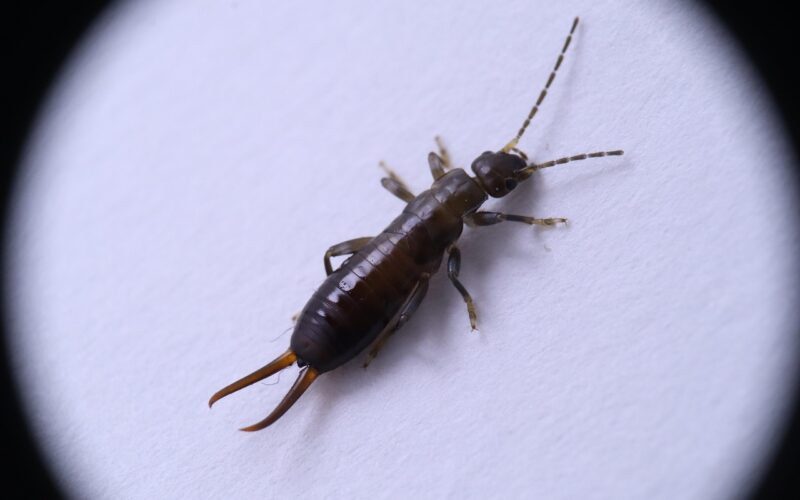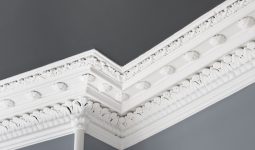Ever wondered why those creepy little pincher bugs keep showing up in your home and garden? Earwigs are drawn to specific conditions that make your property an ideal habitat for them.
Earwigs are primarily attracted to dark, moist spaces that provide protection and sufficient food sources like decomposing organic matter, smaller insects, and garden foliage.
These nocturnal creatures seek shelter in cracks in your foundation, behind peeling wallpaper, or under piles of clutter.
They’re particularly fond of rotting wood and damp areas around your yard.
You might notice them more often in your garden, especially if you have plants that earwigs like.
Understanding what draws earwigs to your property is the first step in effective earwig control.
When you know what these pests are looking for, you can take targeted steps to make your home and garden less appealing to them.
From removing excess moisture to sealing entry points, there are several practical ways you can discourage these pincher bugs from taking up residence in your space.
Moist Or Damp Environments
Earwigs have a strong preference for damp areas. They naturally seek out moist environments because these conditions help them survive and thrive.
You’ll often find earwigs in your home’s most humid spots. Bathrooms, basements, and areas under sinks are prime locations for these pests due to their higher humidity levels.
Why moisture attracts earwigs:
- Prevents their bodies from drying out
- Creates ideal breeding conditions
- Attracts other small creatures they feed on
- Mimics their natural outdoor habitat
Standing water and dampness draw earwigs indoors, especially during dry weather. When the outdoors becomes too hot or dry, these insects seek refuge in the moist areas of your home.
To prevent an earwig infestation, focus on reducing excess moisture. Fix leaky pipes, improve ventilation in humid rooms, and use dehumidifiers in damp basements.
Outdoor areas around your home can also contribute to earwig problems. Flower beds and mulched areas retain moisture and provide perfect hiding spots for earwigs before they make their way inside.
Regular inspection of your property for damp spots can help you identify potential earwig entry points. Check dark corners, crawl spaces, and areas with poor air circulation for signs of excess moisture.
Mulch And Leaf Litter
Earwigs are naturally drawn to damp, dark environments where they can find both shelter and food. Your garden’s mulch and leaf litter create the perfect habitat for these nocturnal creatures.
Organic mulch provides an ideal environment for earwigs because it retains moisture and offers protection. Earwigs thrive in damp and dark environments where they can hide during daylight hours.
When you use materials like straw or wood chips in your garden, you’re inadvertently creating earwig-friendly spaces. These organic materials provide ample hiding spots and retain the moisture that earwigs love.
Leaf litter is another major attractant for earwigs in your yard. When you allow fallen leaves to accumulate, you’re essentially rolling out the welcome mat for these insects.
During fall months, it’s particularly important to keep your yard clean. Having leaf litter can attract earwigs since they seek out moisture and shade.
Earwigs aren’t just looking for shelter in these materials—they’re also hunting for food. As omnivores, they have a preference for decaying organic matter including both leaf litter and mulch.
Your compost piles can also become earwig magnets. Like mulch and leaf litter, compost provides both the dampness and decomposing organic matter that earwigs find irresistible.
Rotting Wood
Earwigs are strongly attracted to rotting wood because it provides them with both food and shelter. When wood begins to decay, it creates the perfect moist environment that earwigs love.
You might notice these pests gathering around old stumps, fallen branches, or damaged wooden structures around your property. The decomposition process creates tiny crevices where earwigs can hide during the day.
Moisture is the key factor that makes rotting wood so appealing to earwigs. When wood gets wet and begins to break down, it becomes softer and easier for small insects to inhabit.
Wood piles are particularly attractive to earwigs, especially when left uncovered outdoors. The spaces between logs offer dark hiding spots, and the wood often retains moisture, creating ideal living conditions.
Though earwigs don’t actually eat solid wood, they do consume the fungi and other organisms that grow on decomposing wood. This is an important distinction from termites, which directly damage wooden structures.
To reduce earwig populations around your home, you should:
- Move wood piles away from your house
- Remove fallen logs and branches promptly
- Fix leaky outdoor faucets that could dampen wood
- Ensure proper drainage around wooden structures
- Consider raising wood piles off the ground
Addressing rotting wood issues not only helps control earwigs but also prevents other moisture-loving pests from establishing themselves near your home.
Overwatered Soil
Earwigs are naturally drawn to moist environments, making overwatered soil an irresistible attraction for these pincer-tailed insects. When you water your garden too frequently, you create the perfect habitat for earwigs to thrive.
These pests avoid completely saturated soil but are strongly attracted to consistently damp areas. Overwatered lawns, leaky faucets, and poor drainage create ideal conditions for earwigs to set up home in your garden.
You might notice earwigs congregating in areas where water tends to pool or where soil remains wet for extended periods. This is particularly common near downspouts, in low spots in your yard, or around frequently watered potted plants.
To remove excess moisture and make your garden less appealing to earwigs, consider these practical solutions:
- Adjust your watering schedule to allow soil to dry between waterings
- Improve drainage around your home and garden beds
- Fix any leaking outdoor faucets or pipes promptly
- Install proper drainage systems in areas that tend to collect water
Earwigs can easily navigate up wooden surfaces and may move from damp soil into your home through foundation cracks if the conditions outside become too wet.
Remember that while controlling moisture is important, earwigs actually help aerate soil, improving water infiltration for your plants. The goal isn’t to eliminate all moisture, but to manage it effectively.
Basement Or Crawl Space Humidity
Earwigs love damp, humid environments, making your basement or crawl space an ideal habitat for these pincer-tailed insects. Homes with crawl spaces or dirt floor basements are particularly attractive to earwigs seeking shelter.
The natural moisture retention in these below-ground areas creates perfect conditions for earwigs to thrive. When outdoor weather becomes too hot or dry, these pests will actively seek out the cool, damp sanctuary your basement provides.
Why basements attract earwigs:
- High humidity levels
- Consistent moisture
- Dark environments
- Protection from predators
- Stable temperatures
You might notice more earwigs in your basement during seasonal changes or after heavy rainfall. This happens because basements and crawl spaces are often dark and damp, creating ideal conditions for an earwig infestation.
Effective moisture control methods:
- Install a quality dehumidifier
- Seal foundation cracks
- Improve ventilation
- Address leaky pipes promptly
- Use moisture barriers in crawl spaces
Properly sealing your crawl space can significantly reduce earwig attraction. A dehumidifier will help maintain lower humidity levels, making your basement less appealing to these moisture-loving pests.
Pay special attention to areas around pipes and corners where condensation tends to collect. Regular inspection of these moisture-prone spots can help you identify and address conditions that might attract earwigs before an infestation develops.
Cracks And Crevices In Foundations
Earwigs love to find their way into your home through cracks and crevices in foundations. These tiny gaps serve as perfect entry points for these nocturnal pests seeking shelter and moisture.
Even the smallest openings in your foundation can become doorways for earwigs. They can squeeze through gaps as narrow as 1/16 of an inch, making almost any crack a potential entrance to your home.
Common foundation entry points include:
- Gaps where utility pipes enter the house
- Cracks in concrete foundations
- Spaces between foundation and siding
- Unsealed basement windows
- Damaged mortar between bricks
These insects are especially attracted to damp foundation cracks that provide both access and the moisture they crave. Foundation cracks near garden beds create an easy bridge from their outdoor habitat right into your home.
You can prevent earwig invasions by sealing these potential entryways. Use caulk, concrete patch, or weather stripping to close gaps and cracks around your foundation.
Pay special attention to entry points at ground level where earwigs are most likely to find their way inside. A thorough inspection of your foundation’s perimeter can reveal problem areas you might have missed.
Remember that gaps in foundations are among the prime entryways for earwigs. Taking time to seal these openings not only keeps earwigs out but also improves your home’s energy efficiency.
Dense Vegetation Or Ground Cover
Earwigs love hiding in dense vegetation and ground cover around your home. These damp, dark spaces provide perfect shelter for these nocturnal creatures to rest during daytime hours.
Gardens with thick mulch, overgrown plants, and crowded vegetation create ideal earwig habitats. Dense vegetation near your home’s exterior creates a bridge for earwigs to move from your garden into your house.
Common vegetation that attracts earwigs:
- Thick ground cover plants
- Overgrown shrubs
- Tall grass
- Dense flower beds
- Excessive mulch
Your vegetable garden is particularly attractive to earwigs because it offers both food and shelter. Earwigs are omnivores that feed on both plants and insects found in your garden.
Rocks and decorative stones in gardens provide excellent hiding spots. Earwigs can gather under these stones during the day before emerging at night to feed.
To reduce earwig populations, try these prevention tips:
- Remove dead plants and fallen leaves regularly
- Prune away fruit tree suckers
- Eliminate dense undergrowth around vegetable gardens
- Keep mulch thin (1-2 inches) and dry
Your garden maintenance routine should include checking under pots, garden ornaments, and rocks where earwigs gather. Regular pruning helps increase airflow and reduces moisture that attracts these pests.
While earwigs can damage plants, they also eat other pests like aphids. This creates a complicated relationship with gardeners who sometimes benefit from their presence.
Compost Piles
Earwigs are strongly attracted to compost piles because these areas provide everything they need to thrive. Your compost bin can become a prime earwig habitat since it contains abundant food sources and moisture.
These insects love the decomposing organic matter found in compost. They feed on decaying plant materials and other microorganisms living in your pile. The dark, damp environment also provides perfect shelter for earwigs to hide during daylight hours.
Your compost attracts earwigs especially when it has:
- High moisture content
- Plenty of decaying leaves and plant material
- Protected dark spaces between materials
- Consistent warmth from decomposition
While earwigs in compost aren’t necessarily harmful, their numbers can grow quickly. Maintaining a balanced compost pile with the right mix of carbon-rich and nitrogen-rich materials (aim for a 3:1 ratio) can help prevent excessive populations.
If your compost pile is close to your home, you might notice more earwigs indoors. Consider placing compost bins further from your house to reduce the chance of them migrating inside.
Managing Earwigs in Compost:
- Turn your pile regularly to disrupt their habitat
- Control moisture levels (damp but not soggy)
- Use enclosed bins rather than open piles
- Keep the area around your compost clear of extra debris
Cardboard, Newspapers, Or Cluttered Areas
Earwigs love hiding in dark, damp places, and cluttered areas inside your home provide perfect hiding spots for these pests. Piles of newspapers, cardboard boxes, and general clutter create ideal environments where earwigs can thrive.
When you leave cardboard boxes in your garage or basement, you’re essentially creating earwig hotels. These materials retain moisture and provide the dark environment that earwigs seek during daylight hours.
Newspapers and other stored items are particularly attractive to earwigs, especially when placed in already damp areas like basements or bathrooms. You might notice earwigs congregating in these spots during your cleaning sessions.
Effective prevention methods include:
- Regularly decluttering storage areas
- Keeping cardboard boxes elevated off the floor
- Disposing of old newspapers promptly
- Maintaining proper sanitation throughout your home
You can also use rolled-up newspapers as traps to catch earwigs. Simply place these rolls in areas where you’ve spotted earwigs, then dispose of them in the morning.
For natural prevention, neem oil can be applied to entry points and potential hiding spots. This natural repellent disrupts earwig behavior without harsh chemicals.
Sprinkling diatomaceous earth around cluttered areas can also help control earwig populations. This natural powder damages the exoskeletons of earwigs that crawl through it, effectively reducing their numbers in your home.
Leaky Faucets Or Drains
Earwigs are strongly attracted to moisture, making leaky faucets and drains perfect entry points for these pests. They thrive in damp, dark environments such as bathrooms, kitchens, and basements.
Your leaky pipes create ideal conditions for earwigs to flourish. These pests are particularly drawn to sweating pipes and areas with poor sealing, which provide both moisture and access points into your home.
Watch for earwigs in these common wet areas:
- Around bathroom floor drains
- Near kitchen sink plumbing
- Under laundry tubs
- Around basement drain pipes
- Near water heaters with condensation
You’ll often find them hiding near floor drains and leaky pipes, especially in downstairs bathrooms. They seek out these damp spots for both shelter and the humidity they need to survive.
How to address the problem:
- Fix all leaking faucets and pipes promptly
- Use a dehumidifier in damp areas of your home
- Install drain covers with small holes that allow water through but keep pests out
- Regularly clean drain covers to prevent clogs from hair and debris
- Check under sinks for condensation and address any moisture issues
By eliminating these water sources, you make your home much less appealing to earwigs. Regular inspection of pipes and prompt repairs can significantly reduce the risk of an earwig infestation.








